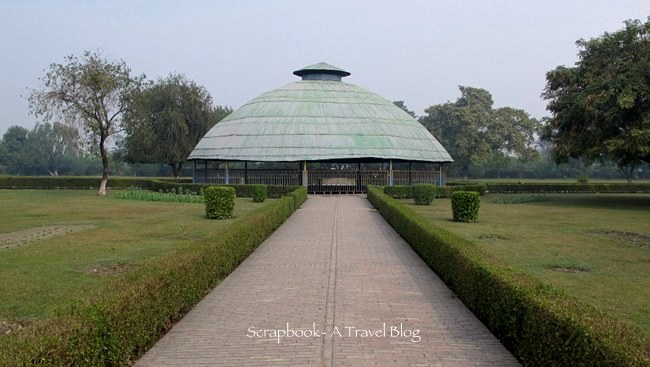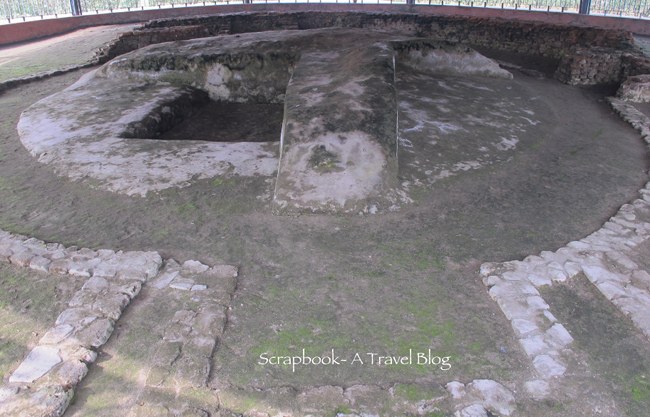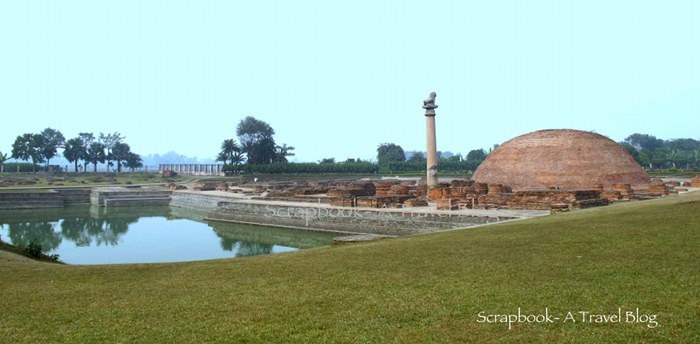 |
| Canopy over Relic Stupa |
To move in and around Patna city you will have to catch private buses and there is a separate stand for private buses- Mitapur. I got off from the shared autorikshaw and was nervous to see the dusty place with hundreds of old battered buses parked. It is insanely crowded place with bus drivers screaming to get passengers into their buses. I got into one of those numerous buses which would drop me near Vaishali. The bus driver and front seat passengers were kind enough to ask me the purpose of my visit so that they can drop me at the nearest cross road to my destination. After passing some green pastures of rice fields, banana groves I reached the outskirts of Vaishali. The bus stopped on the highway and I had to walk about a KM and half to reach the places of interest. There were no autorikshaws or cycle-rikshaws near the bus stop. One of the very few people sitting in the small tea stall there asked me what was I doing there. I told him about my interest. He stopped a passing motorcyclist and ordered him to drop me at the Relic Stupa! I was hesitant but the person insisted on taking a ride instead of walking all the way.
 |
| Relic or Nirvana Stupa |
Being near to the capital city of Pataliputra (now Patna) Vaishali was the center for trade and industry. It seems Vaishali has a mention in the Hindu Epic Ramayana too. Bhagavan Mahavira was born here making this place sacred to Jains. Even before Buddhists Vaishali was capital city of Licchavis. They built the Relic stupa over their share (1/8th portion) of Lord Buddha's relics. I was the only tourist there but, probably on some important days Buddhist pilgrims gather in great numbers. Very cleanly maintained garden around though there was no security for the stupa other than gardeners.
 |
| World Peace Pagoda and the Coronation Tank in Vaishali |
Initially, Lichchavis had a mud mound built as a stupa, but in later years the it was enlarged 4-5 times its size by Mauryan, Sunga and Kushan dynasties. The casket found in here is now preserved in the museum of Patna, to see this the visitor has to pay Rs 100 (A separate ticket along with the entry fees to the musuem). The casket is kept in the glass enclosure inside a separate room. I visited the museum during my second visit to Patna city when I was returning from Gaya. I wasn't aware of the casket details during my first visit. Just across the Relic stupa there is a water tank called Coronation tank. It seems the sacred water from this tank was used for the coronation those days. Across the tank stands the Japanese peace pagoda. I walked around the place for about a kilometer or two on the plastic strewn roadside. The water of coronation tank seems sacred only when seen beyond the vision eyes. Otherwise, a lot of urine and faeces all around.
 |
| Ashoka Pillar, Ananda Stupa, Ramkund in Kutagarasala Vihara in Kolhua |
About 1.5KM away is the other part of ancient Vaishali called Kolhua. Since autorikshaws are very rare to see here, I had to wander around to look for any other mode of transport. After walking another KM to the highway I saw a skinny man with a battered cycle-rikshaw. He was ready to take me to Kolhua for Rs 70 both ways. He seemed eternally happy to get a passenger. After passing the foggy rural Bihar scenes of green fields, goats grazing, dogs watching, hay munching buffaloes, women making cow-dung cakes, chickens running out of huts, I was at the Archaeological site.
Kolhua- where Buddha gave his last sermon before heading to Khushinagara where he attained mahaparinirvana. To commemorate the event of the last sermon Emperor Ashoka erected a Lion pillar. The lion faces north in the direction Lord Buddha headed to Khushinagara. Ananda stupa is beside the pillar. Lord Buddha visited Vaishali frequently and a legend says- on one of the occasions a group of monkeys dug a pond for the Lord and offered a bowl of honey. This pond still exists beside the stupa and is called Ramkund. Around here are the remnants of the monasteries which were once occupied by Lord Buddha and his disciples called Kutagarasala Vihara.
 |
| Sculpture depicting monkey offering a bowl of honey to Lord Buddha |
A small museum in Vaishali near the Relic Stupa displays few interesting ancient sculptures. One of them is the sculpture depicting monkey offering a bowl of honey to the Lord. There are few modern day monasteries near Relic stupa. After returning from the Kolhua site the cycle-rikshaw-wallah left me at the main road from where I could get a bus to Patna city. I gave him a Rs 100 note which was crisp. He was overjoyed to see a blue note in his hand! He touched it to his forehead, he was praising God with tears in his eyes. I asked him if he was okay. He said "yes! I had never held this big a note in my hands in my life". Hearing that I too got tears in my eyes. I told him not to waste that money on alcohol, and told him to buy some nice food for his kids instead. I didn't ask for Rs 30 change which I don't think he had anyway. People are poor even beyond our imaginations. Well, Ashokan Pillar made the poor man's day! And that is what tourism is meant to be!
---
Leave a comment to share your beautiful thoughts and constructive feedback. If you have enjoyed this article then connect with Google+, Twitter, Facebook or subscribe through email for more exciting updates!
Related articles-
Sarnath, where Buddha gave his first sermon
The great stupa of Sanchi
Nadkalasi- A neglected past of Karnataka
Mesa Verde National Park- Castles on the cliffs!
Pompei- the city buried under volcanic ash!
If you want pictures please ask me :)
---

Scrapbook- A Travel Blog by Kusum Sanu is licensed under a Creative Commons Attribution-NonCommercial-NoDerivs 3.0 Unported License.
No comments:
Post a Comment
I would appreciate to have your precious thoughts, suggestions and kind encouraging words in comments. Please do not include self-promotional links.I am encountering some problems because of these links and hence I may not publish them.